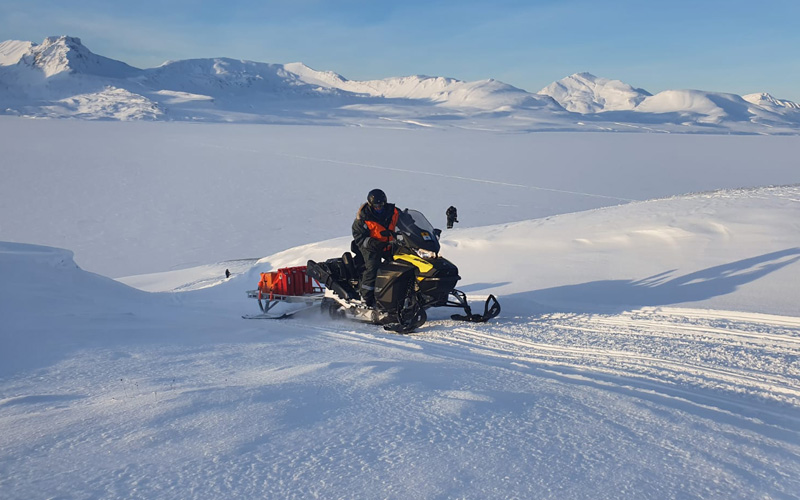From the High Arctic to Mount Washington’s Alpine Tundra
2022-06-20 13:43:57.000 – Hayden Pearson, Weather Observer & Education Specialist
 Hayden Pearson driving to fieldwork in central Spitsbergen. Image taken by fellow researcher Cody Barnett.
Hayden Pearson driving to fieldwork in central Spitsbergen. Image taken by fellow researcher Cody Barnett.
Transitioning from working in the high Arctic to the top of Mount Washington has had its fair share of similarities. My name is Hayden Pearson and I am the newest Weather Observer and Research Specialist working here on New England’s tallest peak.
I am incredibly excited for this opportunity to contribute to the work being done up here at the Observatory and get settled into life on the summit. I am originally from New England, growing up in southern Maine and spending much of that time exploring the outdoors of New England. Hiking through the White Mountains in the summer and skiing throughout the country in the winter developed a passion for the outdoors and occurrences within our natural world.
These experiences led me to getting a degree in Earth and Climate Sciences from the University of Maine before eventually moving to Tromsø, Norway to pursue a Master’s degree, studying how glaciers react to changing atmospheric and oceanic conditions in western Greenland and central Spitsbergen. Velocity and strain analysis were conducted across the glacial terminus and compared with meteorological conditions and the state of the sea ice while in place.
During both my undergrad and graduate degree programs, I was able to live and work in the Arctic, and I have noticed some stark similarities between living on the top of Mount Washington and the top of the world. The lack of trees and other tall vegetation here in the high alpine regions of the White Mountains reminds me of the Arctic tundra. While the weather can change just as fast at 70+ degrees north, the winds generally are not as high on a daily basis. Additionally, much like in the Arctic, on the summit when you get nice weather and sunny skies, you take advantage of them because they are few and far between!
 Ski touring in Svalbard. Image taken by fellow researcher Joe Buckby.
Ski touring in Svalbard. Image taken by fellow researcher Joe Buckby.
The winter on top of the mountain is what really got me interested in applying for a position at Mount Washington Observatory. While this period of the year may seem cold and isolating for some, I find it is when the environment really comes alive. The snow and rime ice provide endless fascination as they are constantly changing and reforming based on the current meteorological conditions.
My first shift on the summit was a treat because we had several nice days allowing for an evening hike after dinner. We were also able to spend time looking for the visual land markers that let us determine the extent of visibility from the summit before inevitably getting socked in the fog again as the week progressed.
 Hayden Pearson and Jackie Bellefontaine, both Weather Observers/Education Specialists (UMaine alums taking over the summit!).
Hayden Pearson and Jackie Bellefontaine, both Weather Observers/Education Specialists (UMaine alums taking over the summit!).
Life at the Observatory has been taken up with a lot of trainings so far in order to learn all of the nuances of taking weather observations but also just making sure everything is running smoothly each day at the weather station. The highlights of the evening include sitting down for a family-style dinner and hearing about each person’s day before taking time to study the METAR booklet or challenging the NH State Parks staff to a round of Mario Kart.
For anyone who doesn’t know what METAR (METeorological Aerodrome Report) is, it is the standardized guide that observers follow for writing and coding all of the weather seen here on the summit. All of the current staff have been a huge help in learning how to translate the weather we document outside into METAR code, as it can be quite a challenge at times. I’m excited to see what future adventures arise from working here and to keep learning all the neat things that make this the “Home of the World’s Worst Weather”!
Hayden Pearson, Weather Observer & Education Specialist
 Hayden Pearson driving to fieldwork in central Spitsbergen. Image taken by fellow researcher Cody Barnett.
Hayden Pearson driving to fieldwork in central Spitsbergen. Image taken by fellow researcher Cody Barnett. Ski touring in Svalbard. Image taken by fellow researcher Joe Buckby.
Ski touring in Svalbard. Image taken by fellow researcher Joe Buckby. Hayden Pearson and Jackie Bellefontaine, both Weather Observers/Education Specialists (UMaine alums taking over the summit!).
Hayden Pearson and Jackie Bellefontaine, both Weather Observers/Education Specialists (UMaine alums taking over the summit!).



